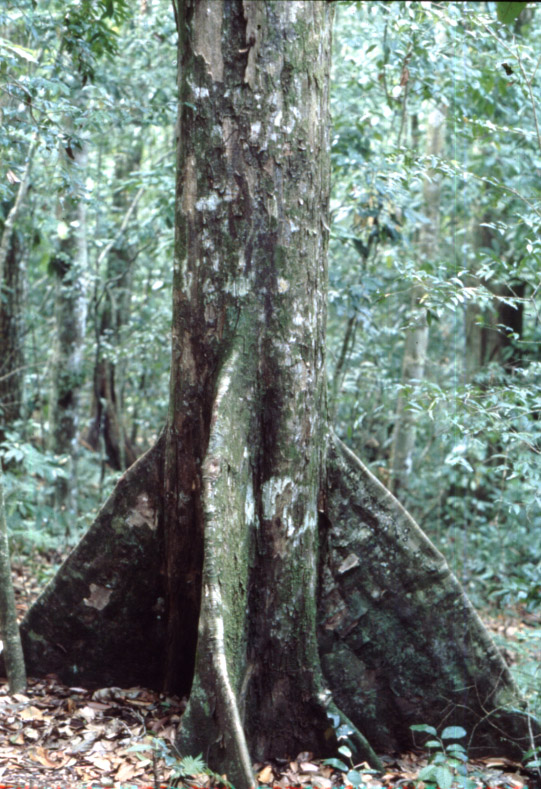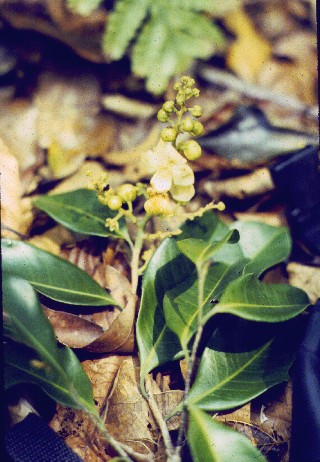Eschweilera harmonii S.A.Mori.
Lecythidaceae PAPALLO
Occasional evergreen canopy tree (25-35 m) found growing in most well drained, primary forest habitats and sometimes forming small stands. Papallo, the only representative of the Lecythidaceae (Brazil Nut) family found in Manuel Antonio, is a very distinctive and unusual tree, thanks to its showy yellow flowers, persistent saucer-shaped fruits, and massive stature. Previously identified as Eschweilera neei, this tree was later identified as a new species in 2007 by Scott A. Mori (see GBIF).
Description: The trunk of this imposing tree grows to be over a meter in diameter. Rising through the dark forest understory, the bole is cylindrical and straight – appearing as a mighty column erected to support the vaulted jungle roof high above. Very prominent, abrupt, thin, and extended buttresses emerge from the trunk about 2 meters above the forest floor and enter the soil about the same distance from its base. In size, shape, and relation to the main trunk, they often resemble the stabilizing fins of a rocket. Papallo bark is mottled with varying shades of brown and gray, with lighter areas representing younger bark exposed when older pieces fell away. Exfoliation is an important process in this species and it occurs in characteristic, irregularly shaped – often scalloped – sections. Dark green and off-white tones are often present on tree’s outer cortex as well, caused by the colonies of moss and lichens that grow there. Finally, the bark is tough and fibrous (difficult to cut through) and covered with elevated point lenticels. Clear, strong-smelling, resinous sap is abundantly found in all plant parts. Papallo boles sustain thick limbs high above the ground, and they extend horizontally for many meters, producing a wide, umbrella shaped crown of moderate thickness.
Leaves (13 by 7 cm) are simple and alternately arranged. The thick, stiff and leathery blades are smooth and basically elliptical in shape, and their rounded apices only occasionally sport small drip-tips. Dark brown or black, thick petioles (1 cm) contrast markedly with the lighter brown color of surrounding twigs. The typically scarce, dark green leaves provide only a meager cover for the branches and all foliage is replaced by pale, translucent leaves in December and January.
Flowers grow from long terminal panicles and are held out and above the foliage by flexible, wiry twigs. The large, globular buds open into yellow blossoms (3.5 cm) consisting of six small, green sepals and rounded, bowl-shaped petals. A prominent, hemispherical appendage, located in the flower’s center, is bristled underneath and serves to cover the multiple stamens and single pistil. Sweetly aromatic, Papallo blossoms smell strongly of the locally popular “Manzana de Agua” fruit. Flowering occurs primarily in May, with occasional fertility observed as early as late April and sometimes carrying over into June. Though an annual event, blossoming varies markedly in intensity from season to season.
Fruits expand rapidly from the ovary after fertilization, and many are aborted while still small. Soon, the crop stabilizes as the fruits develop into large (4.5 cm), woody capsules. With a deep, bowl-shaped base and a thick, pointed lid or cap, each fruit is olive green and speckled with rust-colored lenticels. When mature, the capsules shed their lids while still in the trees, revealing from one to four (usually two) dark brown, waxy, and essentially globular (they may possess flat surfaces) seeds (2 cm). Each seed is further decorated by a prominent network of white veins that run across its glossy surface. In the pod, these seeds are partially covered by a pungently odorous, (garlic-like) fleshy, white aril that is foraged by forest animals. Seeds eventually fall to the ground where they germinate in the moist soil within 2-3 weeks – if they are not first eaten by ground-dwelling mammals. The old woody capsules are also shed and they persist under the trees, intact, for as long as several years. Large harvests are basically annual events, with occasional seasons seeing only limited and sporadic fruiting activity. Crops mature in July and August.
Similar Species: This tree possesses many unique and therefore positively identifying characteristics, not the least of which is its ostentatiously mottled and buttressed trunk. In other parts of the country, trees of the Lecythidaceae family with similar – but larger – bowl-and-lid-shaped fruits exist. For example, in La Selva, the Monkey Pot tree (Lecythis ampla) is an enormous, emergent species with equally impressive, woody pods. In the Osa Peninsula, Lecythis mesophylla sports massive capsules (12 cm) with large, wedge-shaped, glossy brown seeds and odorous, fleshy arils.
Natural History: Papallo flowers are pollinated by large bees, usually visible from the ground during the day. At night, it is probable that they are visited by bats. Fruits are dispersed by arboreal mammals (especially bats) that forage for the white aril found on the seed. Once on the forest floor, Papallo seeds are apparently actively perused by ground-dwelling rodents – for they do not remain in evidence for very long.
The long stalks that support the flower and fruit panicles are flexible and quite tough, allowing these important structures to be maintained in positions of high visibility to potential pollinators and seed-dispersers without risk of breakage due to wind exposure or the excess weight of clinging animals. Buttress roots, in Papallo as well as other tropical trees, probably evolved as extra support structures. Thanks to the paucity of nutrients found in the deeper layers of many tropical soils, arboreal root systems often tend to be shallow. The fin-like buttresses then widen the base of the tree, adding stability in the absence of deeply anchoring tap roots.
Uses: The Lecythidaceae family includes the Brazil Nut (from the Amazonian tropics) as well as several other trees with edible seeds. There is also at least one species (Lecythis minor) whose seeds contain toxic amounts of selenium (Hartshorn, 1978). It is possible that the seeds of Papallo are edible, though, to my knowledge, they have not been sampled.
Papallo’s fibrous bark could be used in rope making. Strips of the inner cortex from other Eschweilera species native to the Amazon basin have been used by indigenous peoples as strong cord straps (Hartshorn).
Apparently, the empty pods of many Lecythis sp. (Monkey Pot) trees have been filled with bait and used as monkey traps. When the animal tries to withdraw food from the pod, its closed fist fails to fit through the narrow opening. Unwilling to release the contents of its hand in order to withdraw it, the monkey can be approached and captured.
Distribution: In Costa Rica (and the world), Papallo is known only from Manuel Antonio. Here it grows, often forming small groves or stands, throughout the park – though it is not a component of the beachside vegetation. Visitors can find Papallo in Punta Catedral and along the early portion of the Puerto Escondido trail.
Photos: Tree Trunk Trunk2 Bark Leaf Flower Flower2 Fruit&Seed Fruit&Seed2 Fruit&Seed3



